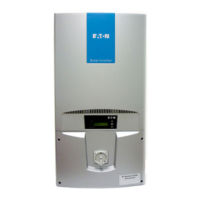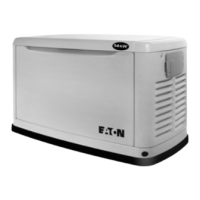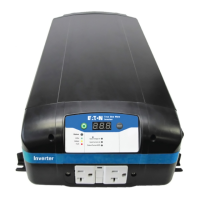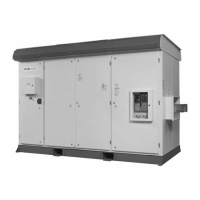Do you have a question about the Eaton MMX34AA012F0-0 and is the answer not in the manual?
Warning about hazardous voltage and necessary precautions before installation and operation.
Safety measures to disconnect power, prevent restarts, verify isolation, and handle electrostatic discharge.
Details standardized input voltages, frequency ranges, and voltage tolerance bands for M-Max frequency inverters.
Provides general operational data including standards, certifications, climatic proofing, ambient temperature, and mounting position.
Details how M-Max inverters connect to AC power networks, including considerations for TN/TT networks and IT networks.
Explains standardized input voltages, frequency ranges, and voltage tolerance bands for M-Max frequency inverters.
Discusses the selection of fuses and cable cross-sections based on rated input current and voltage drop considerations.
Explains the function of RCDs for person and animal protection and specifies the need for AC/DC sensitive RCD type B.
Introduces the chapter on installation and electrical connections for the M-Max series frequency inverters.
Provides general installation instructions for M-Max series frequency inverters under IP20 protection type, and mentions optional accessories for NEMA 1 (IP21).
Specifies the allowed mounting positions for M-Max devices, including tilt limits and disallowed orientations.
Provides recommendations for EMC-compliant installation within a control panel, focusing on grounding and surface connections.
Explains the importance of cable shields, their connection, and the types of braiding suitable for EMC-compatible connections.
Shows the general connection diagram for three-phase input power to the frequency inverter.
Lists and describes the terminal designations for supply voltage, AC motor connection, protective ground, and brake resistance.
Illustrates the proper grounding connection procedure using cable clamp plates and ensuring a large surface area contact.
Shows the location and arrangement of control signal terminals on the M-Max frequency inverter.
Warns about electrostatic discharge and instructs to ground oneself before touching control signal terminals or the controller PCB.
Shows the connection terminals for the serial interface and the location of microswitch S4 for bus termination.
Details the two-wire RS485 connection for Modbus RTU communication, including bus termination requirements.
Provides a checklist to ensure all installation and wiring steps are completed correctly before placing the frequency converter into operation.
Describes how faults are indicated on the display, their causes, and how the inverter automatically stops.
Explains how to acknowledge and reset error messages using the OK button or digital input DI5, and the implications for automatic restart.
Introduces the M-Max's integrated control unit, detailing keypad elements, LCD display, function keys, and interface.
Provides a visual guide to the control unit's keypad layout, LCD display, function keys, and their respective operations.
Explains how to select and view operational data indicators, showing the display format and units.
Explains how to access parameters via the Quickstart Wizard (P1.1=1) or directly (P1.1=0), detailing the navigation process.
Provides visual flowcharts illustrating guided access (A) and free access (B) to parameters using the Quickstart Wizard and arrow buttons.
Presents a table of preset application parameters for different drive types (Basic, Pump, Fan, High Load) linked to parameter P1.2.
Explains and illustrates the source and sink types for digital inputs, emphasizing failsafe actuation.
Introduces the PID controller functionality, its activation via P9.1, and its role in motor speed control.
Defines PID system deviation (e) and how the digital output OD is activated based on exceeding a control deviation limit.
Explains the conditions under which the FBV signal is issued and its use in direct "two-stage control" applications.
Explains fixed frequencies and their priority over reference values, with details on binary coding and digital input activation.
Explains V/Hz characteristic curves and their importance for motor control, detailing different control procedures selectable via P11.8.
Describes DC braking functionality, how it works, its limitations, and potential motor heating issues.
Explains how the DC braking function is activated based on start frequency and deceleration ramp settings.
Details the DC braking time configuration after a stop command, considering stop function settings and output frequency.
Explains regenerative braking, DC link voltage increase, and the role of the brake chopper and external resistor for higher braking torque.
Covers the implementation of mechanical brake actuation via digital outputs and relay contacts, with parameter references.
Illustrates the mechanical brake's function in relation to frequency, start/stop signals, and digital outputs.
Explains how to link parameters P13.1 (A) and P13.2 (B) logically, with the result assigned to digital outputs DO, RO1, and RO2.
Details parameters for the second motor set (P14), including motor data, drive control, V/f curve, and protection functions.
Explains how to select and view operational data indicators, showing the display format and units.
Details how to set the frequency setpoint value using the operating unit's keypad, including navigation and value storage.
Provides an overview of Modbus as a centrally polled bus system for data transfer between master and slave devices.
Illustrates a typical Modbus network arrangement with a host computer and multiple M-Max frequency inverters as slaves.
Shows a typical Modbus network setup, emphasizing the master-slave communication and the need for bus termination resistors.
Describes the electrical connection for the serial interface A-B using a shielded RS485 twisted-pair cable.
Lists Modbus parameters within the M-Max series, including access rights and fieldbus access information.
Refers to parameter group P6 for defining operating conditions, including control place and setpoint source selections.
Details parameters for analog inputs AI1 and AI2, including signal range, custom limits, and filter time constants.
Details parameters for analog outputs AO, including signal type, minimum value, gain, and filter time.
Covers parameters for drive control, including remote control source, speed reference, frequency limits, acceleration/deceleration times, and start/stop functions.
Warning about hazardous voltage and necessary precautions before installation and operation.
Safety measures to disconnect power, prevent restarts, verify isolation, and handle electrostatic discharge.
Details standardized input voltages, frequency ranges, and voltage tolerance bands for M-Max frequency inverters.
Provides general operational data including standards, certifications, climatic proofing, ambient temperature, and mounting position.
Details how M-Max inverters connect to AC power networks, including considerations for TN/TT networks and IT networks.
Explains standardized input voltages, frequency ranges, and voltage tolerance bands for M-Max frequency inverters.
Discusses the selection of fuses and cable cross-sections based on rated input current and voltage drop considerations.
Explains the function of RCDs for person and animal protection and specifies the need for AC/DC sensitive RCD type B.
Introduces the chapter on installation and electrical connections for the M-Max series frequency inverters.
Provides general installation instructions for M-Max series frequency inverters under IP20 protection type, and mentions optional accessories for NEMA 1 (IP21).
Specifies the allowed mounting positions for M-Max devices, including tilt limits and disallowed orientations.
Provides recommendations for EMC-compliant installation within a control panel, focusing on grounding and surface connections.
Explains the importance of cable shields, their connection, and the types of braiding suitable for EMC-compatible connections.
Shows the general connection diagram for three-phase input power to the frequency inverter.
Lists and describes the terminal designations for supply voltage, AC motor connection, protective ground, and brake resistance.
Illustrates the proper grounding connection procedure using cable clamp plates and ensuring a large surface area contact.
Shows the location and arrangement of control signal terminals on the M-Max frequency inverter.
Warns about electrostatic discharge and instructs to ground oneself before touching control signal terminals or the controller PCB.
Shows the connection terminals for the serial interface and the location of microswitch S4 for bus termination.
Details the two-wire RS485 connection for Modbus RTU communication, including bus termination requirements.
Provides a checklist to ensure all installation and wiring steps are completed correctly before placing the frequency converter into operation.
Describes how faults are indicated on the display, their causes, and how the inverter automatically stops.
Explains how to acknowledge and reset error messages using the OK button or digital input DI5, and the implications for automatic restart.
Introduces the M-Max's integrated control unit, detailing keypad elements, LCD display, function keys, and interface.
Provides a visual guide to the control unit's keypad layout, LCD display, function keys, and their respective operations.
Explains how to select and view operational data indicators, showing the display format and units.
Explains how to access parameters via the Quickstart Wizard (P1.1=1) or directly (P1.1=0), detailing the navigation process.
Provides visual flowcharts illustrating guided access (A) and free access (B) to parameters using the Quickstart Wizard and arrow buttons.
Presents a table of preset application parameters for different drive types (Basic, Pump, Fan, High Load) linked to parameter P1.2.
Explains and illustrates the source and sink types for digital inputs, emphasizing failsafe actuation.
Introduces the PID controller functionality, its activation via P9.1, and its role in motor speed control.
Defines PID system deviation (e) and how the digital output OD is activated based on exceeding a control deviation limit.
Explains the conditions under which the FBV signal is issued and its use in direct "two-stage control" applications.
Explains fixed frequencies and their priority over reference values, with details on binary coding and digital input activation.
Explains V/Hz characteristic curves and their importance for motor control, detailing different control procedures selectable via P11.8.
Describes DC braking functionality, how it works, its limitations, and potential motor heating issues.
Explains how the DC braking function is activated based on start frequency and deceleration ramp settings.
Details the DC braking time configuration after a stop command, considering stop function settings and output frequency.
Explains regenerative braking, DC link voltage increase, and the role of the brake chopper and external resistor for higher braking torque.
Covers the implementation of mechanical brake actuation via digital outputs and relay contacts, with parameter references.
Illustrates the mechanical brake's function in relation to frequency, start/stop signals, and digital outputs.
Explains how to link parameters P13.1 (A) and P13.2 (B) logically, with the result assigned to digital outputs DO, RO1, and RO2.
Details parameters for the second motor set (P14), including motor data, drive control, V/f curve, and protection functions.
Explains how to select and view operational data indicators, showing the display format and units.
Details how to set the frequency setpoint value using the operating unit's keypad, including navigation and value storage.
Provides an overview of Modbus as a centrally polled bus system for data transfer between master and slave devices.
Illustrates a typical Modbus network arrangement with a host computer and multiple M-Max frequency inverters as slaves.
Shows a typical Modbus network setup, emphasizing the master-slave communication and the need for bus termination resistors.
Describes the electrical connection for the serial interface A-B using a shielded RS485 twisted-pair cable.
Lists Modbus parameters within the M-Max series, including access rights and fieldbus access information.
Refers to parameter group P6 for defining operating conditions, including control place and setpoint source selections.
Details parameters for analog inputs AI1 and AI2, including signal range, custom limits, and filter time constants.
Details parameters for analog outputs AO, including signal type, minimum value, gain, and filter time.
Covers parameters for drive control, including remote control source, speed reference, frequency limits, acceleration/deceleration times, and start/stop functions.
| Input Voltage | 380-480V |
|---|---|
| Output Voltage | 0-480V |
| Horsepower | 10 HP |
| Phase | 3-phase |
| Output Power | 7.5 kW |
| Frequency | 50/60 Hz |
| Protection Class | IP20 |
| Cooling Method | Fan cooled |
| Ambient Temperature | -10 to 50°C |
| Altitude | Up to 1000 m without derating |
| Storage Temperature | -40 to 60 °C |
| Relative Humidity | 5-95% non-condensing |











